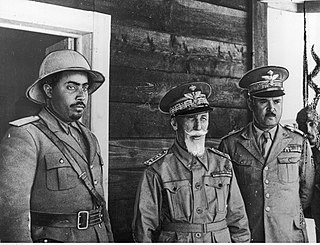Related Research Articles

The Second Italo-Ethiopian War, also referred to as the Second Italo-Abyssinian War, was a war of aggression which was fought between Italy and Ethiopia from October 1935 to February 1937. In Ethiopia it is often referred to simply as the Italian Invasion, and in Italy as the Ethiopian War. It is seen as an example of the expansionist policy that characterized the Axis powers and the ineffectiveness of the League of Nations before the outbreak of the Second World War.
The Battle of Maychew was the last major battle fought on the northern front during the Second Italo-Abyssinian War. The battle consisted of a failed counterattack by the Ethiopian forces under Emperor Haile Selassie making frontal assaults against prepared Italian defensive positions under the command of Marshal Pietro Badoglio. The battle was fought near Maychew, Ethiopia, in the modern region of Tigray.

RasMakonnen Wolde Mikael Wolde Melekot, or simply Ras Makonnen, also known as Abba Qagnew was a Shewan royal from Menz, a military leader, the governor of Harar province in Ethiopia, and the father of Tafari Makonnen. He is ethnically Amhara. His father was Fitawrari Makonnen and was a grandson of Negus Sahle Selassie of Shewa through his mother, Leult Tenagnework Sahle Selassie. As such, he was a first cousin of Emperor Menelik II.
Sultan Olol Dinle was a Somali sultan who ruled Kelafo as the head of the Ajuran clan. He successively offered allegiance to the Kingdom of Italy in the 1920s and was named "Sultan of Sciavelli (Shabelle)" in the early 1930s.

RasDesta Damtew was an Ethiopian noble, an army commander, and a son-in-law of Emperor Haile Selassie I.

Ethiopian forces in the Second Italo-Abyssinian War besides the Central Army were mobilized from various provinces under their local leader. According to 1935 Italian intelligence estimates of the Ethiopian provinces and their forces on the eve of hostilities, the Ethiopians had an army of 350,000 men. Strengths where known are noted followed by their leader. Modernized forces in Bold.

The Battle of Ganale Doria was a battle in 1936 during the Second Italo-Abyssinian War. It was fought on the "southern front". The battle consisted largely of air attacks by the Italian Royal Air Force, under the command of General Rodolfo Graziani, against an advancing and then withdrawing Ethiopian army under Ras Desta Damtu. The battle was primarily fought in the area along the Genale Doria River valley between Dolo and Negele Boran.
De Bono's invasion of Abyssinia took place during the opening stages of the Second Italo-Abyssinian War. Italian General Emilio De Bono invaded northern Abyssinia from staging areas in the Italian colony of Eritrea on what was known as the "northern front".

Seyoum Mengesha KBE was an army commander and a member of the royal family of the Ethiopian Empire.

Haile Selassie Gugsa (1907–1985) was an army commander and a member of the Imperial family of the Ethiopian Empire from Tigray.

Gugsa Araya Selassie was an army commander and a member of the royal family of the Ethiopian Empire.
Getachew Abate (1895–1952) was an army commander and a member of the nobility of the Ethiopian Empire.
Hailu Tekle Haymanot, also named Hailu II of Gojjam, was an army commander and a member of the nobility of the Ethiopian Empire. He represented a provincial ruling elite who were often at odds with the Ethiopian central government. Hailu Tekle Haymanot was an independent-minded potentate who, throughout his life, was mistrustful of and mistrusted by the Emperor.
Nasibu Zeamanuel, also Nasibu Zamanuael or Nasibu Emmanual in some texts, was an army commander of the Ethiopian Empire. Along with his brother Wasane, historian Bahru Zewde groups Nasibu "among the most colourful of the first-generation intellectuals" of Twentieth-century Ethiopia. His maternal grandfather, Azaz Emmanual Wolde Malakot, whose name both brothers came to adopt, was a notable courtier of Emperor.

The 1928 Ethiopian coup d'état was an attempt by supporters of Empress Zewditu to rid her of the heir apparent and Crown Prince, Ras Tafari Makonnen. With Tafari gone, Zewditu would be the sole ruler of the Ethiopian Empire.
Gugsa Wale's rebellion of 1930 was a rebellion raised by Ras Gugsa Wale and by supporters of Empress Zewditu to rid her of the Crown Prince and heir apparent, Negus Tafari Makonnen. With Tafari gone, Zewditu would be the sole claimant to succession as the ruler of the Ethiopian Empire. As the husband of Empress Zewditu, Gugsa Wale expected to become Emperor.
Major-General DejazmatchBeyene Merid was an Ethiopian army commander, a patriot, and the son-in-law of Emperor Haile Selassie I.
Ayalew Birru, or Ayyalaw Birru, was an Ethiopian army commander, a patriot, and a cousin of Emperor Haile Selassie I.
Fikremariam was an Ethiopian commander and a patriot.
Adefrsew Yenadu (1873–1950) was an army commander, a member of the nobility of the Ethiopian Empire, and a patriot.
References
- Barker, A.J. (1971). Rape of Ethiopia, 1936. New York: Ballantine Books. ISBN 978-0-345-02462-6.
- Haile Selassie I, Edited by Harold Marcus with others and Translated by Ezekiel Gebions with others (1999). My Life and Ethiopia's Progress: The Autobiography of Emperor Haile Selassie I, King of Kings and Lord of Lords, Volume II. Chicago: Research Associates School Times Publications. p. 190. ISBN 0-948390-40-9.
{{cite book}}:|first=has generic name (help) - Marcus, Harold G. (1994). A History of Ethiopia . London: University of California Press. pp. 316. ISBN 0-520-22479-5.
- Pankhurst, Richard (2001). The Ethiopians: A History (Peoples of Africa). Wiley-Blackwell; New Ed edition. ISBN 0-631-22493-9.